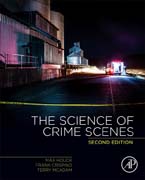
The crime scene is the alpha and omega, the sine qua non, the epicenter of forensic science. Rightfully so, the primacy of the crime scene is emphasized in typical text and technical books but often at the expense of the science behind the process of a properly-worked scene. The updated 2nd edition of The Science of Crime Scenes offers a science-based approach to crime scenes, one that stresses the why? as much as the how?, emphasizing that understanding is more important than just knowing. Without sacrificing technical details, The Science of Crime Scenes adds significantly to the philosophy and theory of crime scene science. The 2009 National Research Council's report and the President's Council of Advisors on Science and Technology called for more fundamental education and training in the science behind the discipline. Nowhere is this need greater than in crime scene investigations. Long seen as merely bagging and tagging,? crime scene investigation and processing is now a complex process, involving numerous sciences and methods. The 2nd edition addresses the science behind the scenes and demonstrates the latest methods and technologies in depth with updated figures and images. It covers the philosophy of crime scene as historical events, the personnel involved at a scene (including the media), the detection of criminal traces and their reconstruction, and special crime scene, such as mass disasters and terroristic events. Written by an international trio of authors with decades of crime scene experience, The Science of Crime Scenes is the next generation of crime scene textbooks. This volume will serve both as a textbook for forensic programs and an excellent reference for forensic practitioners and crime scene technicians with science backgrounds. Includes in-depth coverage of disasters and mass murder, terror crime scene, and CBRN (Chemical, biological, radioactive and nuclear) - not covered in any other textIncludes an instructor site with lecture slides, images, and links to resources for teaching and training INDICE: SECTION 1: THE SCIENCE OF CRIME SCENE INVESTIGATIONChapter 1.0: The Forensic Mindset?Chapter 1.1: From Scene to Laboratory to CourtChapter 2.0: What Is a Crime Scene?Chapter 2.1: Crime Scene Intelligence: Connecting People, Places, and ThingsSECTION 2: PERSONNEL AND PROCEDURESChapter 3.0: PersonnelChapter 3.1: First Responder on the SceneChapter 3.2: The Investigator in ChargeChapter 3.3: The Forensic Team: Officers, Scientists, and SpecialistsChapter 3.4: Nonforensic Personnel: Superiors, Officials, and the MediaChapter 4.0: General Crime Scene ProcedureChapter 4.1: Freezing? the Scene and the Three R's (Recognize, Recover, and Record)Chapter 4.2: The Chain of CustodyChapter 4.3: Recording the Scene: Sketching, Photography, and VideoSECTION 3: DETECTION AND RECONSTRUCTIONChapter 5.0: Searching for Evidence: RecoveryChapter 5.1: DetectingChapter 5.2: CollectionChapter 5.3: Preserving Chapter 5.4: Submitting Evidence to the LaboratoryChapter 6.0: Evidence Types and EnhancementChapter 6.1: Chemical EvidenceChapter 6.2: Biological EvidenceChapter 6.3: Impression EvidenceChapter 6.4: Other Types of EvidenceChapter 7.0: Crime Scene ReconstructionChapter 7.1: An Archaeological Approach Of Artifacts and EvidenceChapter 7.2: Bloodstain Pattern AnalysisChapter 7.3: Photogrammetry and 3D ReconstructionSECTION 4: SPECIAL CRIME SCENESChapter 8.0: Special Crime ScenesChapter 8.1: Disaster and Mass FatalitiesChapter 8.2: Terrorist Crime ScenesChapter 8.3: CBRN Crime ScenesChapter 8.4: Underwater and Underground Crime Scenes
- ISBN: 978-0-12-849878-1
- Editorial: Academic Press
- Encuadernacion: Cartoné
- Páginas: 478
- Fecha Publicación: 04/10/2017
- Nº Volúmenes: 1
- Idioma: Inglés
